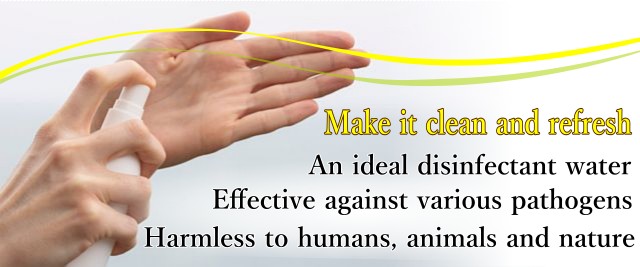
CLEAN·REFRE, a type of NaCl-free hypochlorous acid water(HAW) is an efficient disinfectant even though it is safe for the environment and the human body. Because of the chemical characteristics, it is attracting attention as a cleaning liquid with sterilizing effect useable in a variety of situations such as food manufacture, medical setting, daily life etc.
Please click if you want to know about HAW.
Table of contents
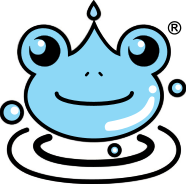 What is CLEAN·REFRE?
What is CLEAN·REFRE?
 Verification of the effect of CLEAN·REFRE
Verification of the effect of CLEAN·REFRE
 Usage examples
Usage examples
What is CLEAN·REFRE?
Three types of HAW are designated as food additives for cleaning by the Ministry of Health, Labor and Welfare of Japan(MHLW). They differ from each other in chemical characteristics (Fig. 1) depending on their production technique.
Fig. 1: Chemical characteristics of CLEAN·REFRE and HAWs designated as food additives by MHLW.
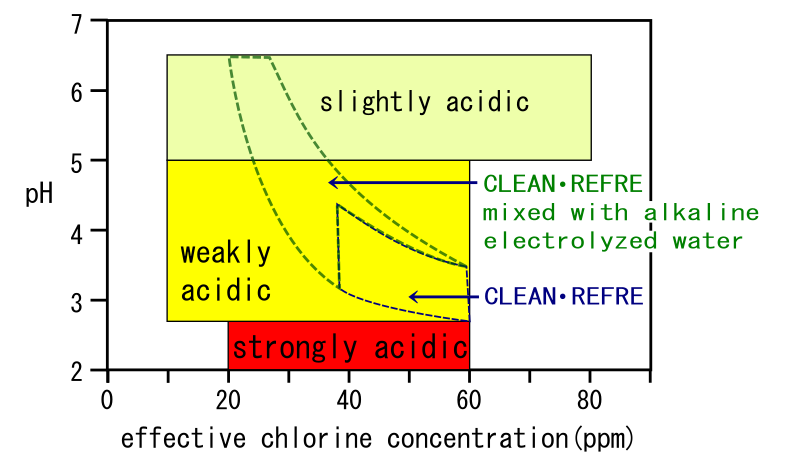
The MHLW standard of the HAWs provides nothing about NaCl concentration. Therefore some of the HAWs on the market possibly contain about 0.2wt% NaCl, even if they conform to the standard. Such products may accelerate metal corrosion where they are applied.
ACT Corporation provides a type of NaCl-free hypochlorous acid water named CLEAN·REFRE. It is made from water and sodium chloride by a three-compartment water electrolyzer named CLEAN·FINE(Fig. 2).
Fig. 2: CLEAN·FINE, a three-compartment water electrolyzer.

In this apparatus, the NaCl solution, as the raw material, and the HAW, as the product, are divided by an anion exchange membrane (Fig. 3). Because sodium exists as a cation in the NaCl solution, no sodium ion moves into the HAW.
The pH of CLEAN·REFRE we usually sell is between 2.7 and 4.5, and the free active chlorine(FAC) concentration is between 35mg/L and 60mg/L. Thus, CLEAN·REFRE corresponds to the weakly acidic hypochlorous acid water defined by MHLW (Fig. 1).
Fig.3: Making CLEAN·REFRE by the three-compartment electrolytic water generator.

Safety for human and cattle bodies
Although CLEAN·REFRE contains only 0.01wt% or less hypochlorous acid, yet it is fatal to microorganisms such as bacteria and viruses. However, it only has a negligible effect on lumps of organic matter like human skin. Compared with general disinfectants, like alcohol or antiseptic soap solutions, CLEAN·REFRE is far less stimulating.
The acidity of CLEAN·REFRE is not too strong to wash your hands with, as compared to a wine whose pH is about 2.5 and to an orange juice of pH 3.5. If you need a less irritant washer solution, we can offer a less acidic neutralized CLEAN·REFRE by mixing the alkaline electrolyzed water in Fig.3 with the original CLEAN·REFRE. In this case, the neutralized CLEAN·REFRE may contain at most 0.002wt% NaCl.
A result of water quality testing by Obihiro Health Center indicates that a sample of neutralized CLEAN·REFRE (pH 6.9) is good to drink, except for its high free available chlorine concentration.
Why do we recommend CLEAN·REFRE?
The majority of food poisoning are infectious diseases caused by microbes such as viruses or bacterias.
We recommend CLEAN·REFRE because it is safe for the human body and the environment, despite its high sterilizing power. We believe that you can realize its effect, especially in winter, when highly contagious viral diseases such as influenza or norovirus infections widely prevail.

Verification of the effect of CLEAN·REFRE
Effect test of CLEAN·REFRE against colon bacillus
We prepared four samples of colon bacillus, which are soaked individually in distilled water: original CLEAN·REFRE, neutralized CLEAN·REFRE, and alkaline electrolyzed water. We cultured the samples on Petri dishes of agar medium in an incubator at a constant temperature of 35 degrees Celsius for 24 hours. As Fig. 4 shows, we did not recognize any colony of colon bacillus on the Petri dishes with samples soaked in original or neutralized CLEAN·REFRE.
Fig.4: Result of the culture tests.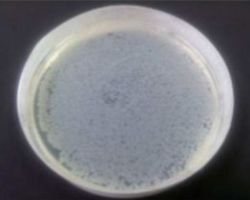 Distilled water
Distilled water
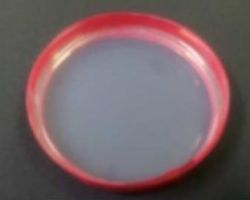 CLEAN·REFRE
CLEAN·REFRE
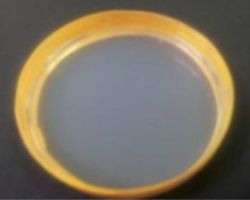 Neutralized CLEAN·REFRE
Neutralized CLEAN·REFRE
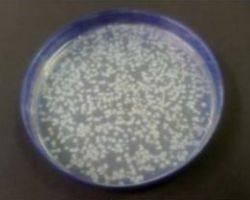 Alkaline electrolyzed water
Alkaline electrolyzed water
Collaboration with universities and research institutes
Of course, CLEAN·REFRE is highly effective against the pathogens listed in Table 1 on the page that explains hypochlorous acid water. Furthermore, through joint research with universities and research institutes, we have independently confirmed the effects of CLEAN·REFRE on several pathogens. A notable achievement is a publication in an international journal of the effect of CLEAN·REFRE on the new coronavirus, which is currently terrorizing the world, in joint research with Obihiro University of Agriculture and Veterinary Medicine.
Below is a list of some of the publicly available research on CLEAN·REFRE:
- CSARS-CoV-2: Takeda et al(2020) Acidic electrolyzed water potently inactivates SARS-CoV-2 depending on the amount of free available chlorine contacting with the virus. Biochemical and Biophysical Research Communications 530 1-3
- SARS-CoV-2: Obihiro University of Agriculture and Veterinary Medicine (2020) Report 1 Proof of inactivating effect of hypochlorous acid water on new coronavirus 1st report
- SARS-CoV-2: Obihiro University of Agriculture and Veterinary Medicine (2020) Report2 Proof of inactivating effect of hypochlorous acid water on new coronavirus 2nd report
Please search here for the above two research reports (in Japanese)
- Porcine epidemic diarrhea virus: Imai et al. (2019) Inactivating effect of hypochlorous acid water on porcine epidemic diarrhea virus, Journal of the Japan Veterinary Medical Association 72 103-106
- Foot-and-mouth disease virus: Bui et al.(2017) Potential of electrolyzed water for disinfection of foot-and-mouth disease virus, The Journal of Veterinary Medical Science 79 726-729
As an example, we want to show you the results of the effect tests of CLEAN·REFRE against the new coronavirus conducted by Obihiro University of Agriculture and Veterinary Medicine. They used three types of hypochlorous acid water with pH2.5, 4.5, and 6.0 as test solutions. The former two are CLEAN·REFRE, and the one with pH 6.0 is a neutralized solution made by mixing CLEAN·REFRE and alkaline electrolyzed water. ACT Corp. provided all the test solutions.
Fig. 5 and Fig. 6 summarize the results. As shown in Fig. 5, when the virus solution volume: test solution volume was 1:9, 99.99% or more of the virus was inactivated 1 minute after mixing with the test solution having a pH of 2.5 and a FAC concentration of 74 mg/L. It means that the viral load has decreased below the detection limit. A phosphate buffer solution adjusted to the same pH by adding hydrochloric acid did not inactivate the virus. Thus we consider that the inactivation is due to the effect of hypochlorous acid rather than low pH.
On the other hand, in similar tests conducted using test solutions with FAC concentrations of 45 mg/L and 29 mg/L, they inactivated more than 99% of the virus in 1 minute. However, even 10 minutes after mixing, the viral load did not reach below the detection limit.
Figure 5: Effect of CLEAN·REFRE on new coronavirus (1)

We also tested with an increased amount of CLEAN·REFRE. Under the condition of the virus solution volume: test solution volume was 1: 15, the test solutions with low FAC concentrations (45 mg/L and 29 mg/L) decreased the viral load to below the detection limit (Fig. 6) 1 minute after mixing.
Figure 6: Effect of CLEAN·REFRE on new coronavirus (2)

From the above results, we judge that a sufficient amount of CLEAN·REFRE with a low FAC concentration of 30 mg/L or less effectively reduces the number of the virus to below the detection limit. And the higher the FAC concentration of CLEAN·REFRE or the higher the amount of CLEAN·REFRE used, the more the viral load reduced. It is often necessary to treat contaminants such as saliva that contain a significant amount of organic matter. Even in such cases, you can sterilize the contaminants by washing with sufficient CLEAN·REFRE.

Usage examples
CLEAN·REFRE is excellent in safety and works well as a germ-removing liquid. Thus it is used on various scenes, and we are getting more and more regular customers.
At kitchens

At nurseries

At hospitals

At farms

At food factories

